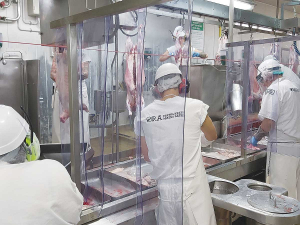US, EU and UK drive NZ red meat export boom to $827m
According to analysis by the Meat Industry Association (MIA), New Zealand red meat exports reached $827 million in October, a 27% increase on the same period last year.
 The MIA is warning that supply chain challenges will significantly disrupt meat exports for some time to come.
The MIA is warning that supply chain challenges will significantly disrupt meat exports for some time to come.
New Zealand's red meat sector export hit $10 billion in 2021 - despite the disruption caused by Covid-19.
According to analysis by the Meat Industry Association (MIA) last year's exports represented a 9% increase on 2020. Meanwhile, the value of red meat and co-products exported in December 2021 was also up 22% year-on-year, at just over $1 billion.
"Despite all the disruptions and labour shortages, we were able to make the most of the global demand for red meat and generate record export revenue," says MIA chief executive Sirma Karapeeva.
However, she warns that supply chain challenges will significantly disrupt exports for some time to come and it is unknown what impact this will have on the Easter chilled trade.
"This illustrates very clearly how critical it is for the industry to have access to sufficient labour including overseas migrants to capture the greatest market value and support the jobs of thousands of hard-working Kiwis."
Overall, both sheepmeat and beef exports increased by 5% and 9% year-on-year respectively, with both worth more than $4 billion for the year. Co-products exports also increased by 19% to almost $2 billion.
Karapeeva says red meat exporters have responded swiftly to adapt to rapidly-changing logistics environments - for instance, by converting chilled product to frozen, when needed, to address risks in the disrupted supply chain.
While chilled sheepmeat exports to the UK dropped by 42% in December, to the lowest volume in 25 years, frozen sheepmeat exports to the UK increased by 95%.
Karapeeva adds that while there has been some softening in Chinese demand for sheepmeat from the previous high levels, prices in China have remained strong.
Sheepmeat export volumes to China dropped by 15% in the fourth quarter. However, the value of sheepmeat exports to China increased by 3% in the same period.
China remained the largest overall importer for the quarter (41%), followed by the US (20%), the UK (4%) and Japan.
China was also the largest beef export market, followed by the US and Japan. Beef export volumes to China were the same as the final quarter of 2020, at 46% of total, but increased 33% by value.
Exports to the US dropped by 15% by volume but increased by 16% in value. Exports to Japan remained the same at 7% of volume but grew 39% by value.
The Government is set to announce two new acts to replace the contentious Resource Management Act (RMA) with the Prime Minister hinting that consents required by farmers could reduce by 46%.
Prime Minister Christopher Luxon says withdrawing from the Paris Agreement on climate change would be “a really dumb move”.
The University of Waikato has broken ground on its new medical school building.
Undoubtedly the doyen of rural culture, always with a wry smile, our favourite ginger ninja, Te Radar, in conjunction with his wife Ruth Spencer, has recently released an enchanting, yet educational read centred around rural New Zealand in one hundred objects.
Farmers are being urged to keep on top of measures to control Cysticerus ovis - or sheep measles - following a spike in infection rates.
The avocado industry is facing an extremely challenging season with all parts of the supply chain, especially growers, being warned to prepare for any eventuality.

OPINION: Your old mate welcomes the proposed changes to local government but notes it drew responses that ranged from the reasonable…
OPINION: A press release from the oxygen thieves running the hot air symposium on climate change, known as COP30, grabbed your…